Alfa's first CA(R)Tastrophe
Part 2: From late January '89 to the first race
Authors
- Henri Greuter & Aldo Canzian
Date
- May 17, 2022
Related articles
- March-Alfa Romeo 89CE - Alfa's first CA(R)Tastrophe, by Henri Greuter/Aldo Canzian
- Introduction
- Part 1: About what happened late 1988 and early 1989, as printed in the British press
- Part 3: The hardware Alfacorse went into combat with: March 89CE and its V8
- Part 4: Alfa's 1989 CART season
- Part 5: Evaluations of the past year, closing the book and into the future
- Appendix 1: The 1989 race results
- Appendix 2: The search for the identities of the two Morales Racing March 88Cs
- March-Alfa Romeo 90CA - Fiasco Italo-Brittanico, by Henri Greuter
- March-Porsche 90P - The last oddball at the Indianapolis Motor Speedway, by Henri Greuter
What?no March-Alfa Romeo 89CE... Where?Indianapolis When?1989 Indianapolis 500 |
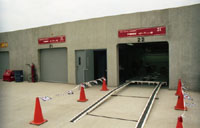 |
Why?
In this part we will look at the events as mentioned in Italian magazine Autosprint dealing with the Alfa Romeo Indycar project as they took place in the time period from late January 1989 until the first event that Alfa Romeo entered. While these Italian articles will serve as the backbone for this part, by using italics yet again, we will add relevant information printed elsewhere which the Italians did not share with their readers. We will also evaluate the Italian articles using both relevant information obtained elsewhere as well as the benefit of hindsight.
The first Autosprint articles we had available and are able to use for our backbone were printed in the edition dated January 31st, the magazine unloading a lot of information onto their readers about the Alfa Romeo Indycar project. A presentation was held at the Alfa Romeo-owned Balocco test track. The title of the article ('To Indianapolis to win immediately') reflected Alfa Romeo's ambitions but were these even remotely realistic?
Engineer Mauro Coppini informed the attendants that the decision to go to Indy was primarily in support of promoting sales of the Alfa Romeo 164. This car was also to be sold on the US market.
Sporting manager Giorgio Pianta made it clear that 1989 was to be a learning year in which they supplied the Morales team. (A statement that was at least a bit more realistic than the title of the article.)
Also present was Johnny Capels, team manager at Morales Racing. According to him, the team had a contract with March for providing the cars while March had a deal with Alfa Romeo to provide the engines. Capels was also asked why all the engine builders involved had opted for a V8 engine instead of going for the V6 option. He answered that none of CART's major engine builders had yet tried out the V6 option and that the presently used V6 engines suffered from reliability problems.
This particular question and answer leads to some interesting observations with regards to the use of a V6 engine. The option of a V6 got a surprising amount of attention. But in the case of Alfa Romeo it was anything but a viable option to begin with and hardly worth a point of attention, let alone a subject for discussion.
Especially for non-Indy fans all of this might read as unknown and hard to understand. For them: let's dive into the history that eventually caused the comments about V6 engines to be made in that 1989 press conference in Italy.
Indianapolis was known to be a race in which, at least in theory, different engine concepts could be used but in the end it resulted in one of the allowed concepts being the superior and thus all-dominant option. In 1960, the all-dominant engine was the 4.2-litre Offenhauser 4-cylinder. An alternative that was tried were 2.8-litre supercharged engines. These engines were permitted to use DOHC cylinder heads and four valves per cylinder. From 1964 on, the Offy was overthrown by the DOHC Ford V8, often referred to as the Ford Quadcam. In 1966 another shift started, the result of which being that from 1968 on the dominant engines became the turbocharged 2.8-litre versions of both Ford and Offy.
Rules also allowed production-based engines ('Detroit Iron') with two valves per cylinder and activated by a single central camshaft and pushrods between the camshaft and valves. By the way, there was no restriction on the number of cylinders of the engines.
To compensate for this compromised cylinder-head design and the less than ideal valve activation, these production-based engines were permitted a substantially larger cylinder capacity. Even in the sixties some attempts were tried with both normally aspirated engines (primarily Chevrolet V8s) and turbocharged engines (AMC Rambler Straight Six) but none of these attempts succeeded.
A bit more success was gained by well-known chief mechanic Smokey Yunick who fielded a twin-turbocharged Chevy V8 mounted on an 1972 Eagle chassis, and he at least managed to get that car qualified in the 1973 and 1975 races, even though the results were not impressive.
AMC gave a turbocharged V8 a try between 1976 and 1979. There was not enough success to continue this project. The capacity of these turbocharged pushrod V8s of the seventies was restricted to 3.43 litres. For comparison, since 1969 the turbocharged DOHC engines had been permitted only 2.65 litres.
The 3.43-litre capacity equals 209 CI so the number 209 is often associated with these turbocharged pushrod stock-block engines.
Then, late in the seventies, USAC introduced several rule changes regarding all the engines that they permitted. This resulted in the fact that apart from a larger engine capacity the turbocharged stock-blocks were also permitted to use more turbo boost in order to generate power and remain competitive with the purebred racing V8 Cosworth DFX, the dominant engine in Indycar since 1978.
The eighties started with attempts with turbocharged Chevy V8 engines in both 1981 and 1982. One of the men putting his faith in such an engine was no less a person than Dan Gurney. One year earlier Gurney's factory Eagle, then fitted with a normally aspirated Chevy V8, driven by Mike Mosley qualified a sensational second on the grid. In 1982, using a turbocharged version, Mosley failed to qualify for the 1982 Indy 500 after a bunch of blown engines.
A major disadvantage of using 'Detroit heritage' V8s was that the starting point of an unblown production block was rather large and heavy. Most of them started out with capacities of 5 litres and/or more. With capacity reduced to the allowed 3.43 litres, the result was a fairly large and heavy engine for its capacity. Some weight reduction was possible when Indy's organizing body (USAC) allowed stock production parts to be replaced with light-alloy copies made by specialists in the hotrod world. Iron blocks being replaced by alloy copies made a world of a difference for example.
The Detroit V6 production engines existing at the time were smaller and lighter. Their capacity was much closer to the permitted 3.43 litres and so they offered a better starting point. This is why we saw the first attempts with a Chevy V6 engine in 1979 (qualified for the race but not a success results-wise) before it continued in 1982 but again without success, while one year later the engines failed yet again. Then in 1984, Buick made its debut with their turbo V6. By the way, neither the Chevy nor the Buick engines were a fully factory supported programme but very much carried out by privateer engine builders.
Curiously enough, even though both of these brands were part of General Motors, while sharing parts and components was not unusual among GM partners, there were distinctive design and construction differences between the two V6 engines. Another difference was that the Buick was used more often, with more engine builders working with them. After the 1983 failures, the Chevrolet V6 was down to a single team still putting its faith in it, even though it was no lesser team than that of Indy hero AJ Foyt. The engine was very much the project of AJ's engine man Howard Gilbert. Results with the engine had been few and reached a level of, and it can't be made any better than that, promising during qualifying but downright embarrassing in the race.
The Buick gained even more of a name and (a better) reputation when the two Buick-powered cars that qualified for the 1985 Indy 500 won the first two starting spots! But also cementing another aspect of their reputation was when both cars were two of the first four retirements, including the very first one...
The reliability of the V6s remained a problem in the years to come.
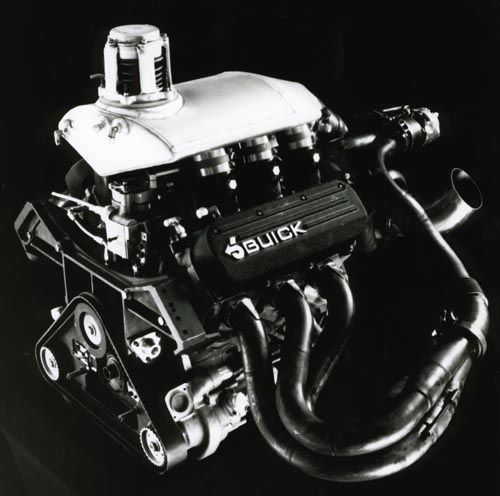
Photo of the Buick Indycar engine as found in the 1988 Buick press kit released during the Indianapolis 500 of 1988.
And here we end the history lesson as of why a V6 engine concept could become a discussion point during a press conference about the Alfa Romeo Indycar plans.
By now, knowing all of this background, you may actually wonder why there was so much focus on V6 engines and why they were considered an option for Alfa Romeo.
All of these matters appear to have been overlooked if not entirely ignored in this Autosprint interview. Anyway, there was no way in which Alfa could have designed a V6 such as the Buick or Chevy V6 from scratch and use it for its Indycar project. Purpose design of such a pushrod engine was not allowed (yet) in 1989, since only a slightly modified version of a production-based engine was permitted. But the Alfa V6 production engine that was available in certain models simply didn't comply to the rules by virtue of their overhead camshafts.

Photo of the 1987 version of the Alfa Romeo DOHC V6 engine as it was used in the Tipo 164 Sedan. (photo Alfa Romeo PR department)
We don't use footnotes in this article otherwise the following rules would have been one. We mentioned that purpose design of such a pushrod engine was not allowed (yet) in 1989 but a few years later, in 1993, this was finally permitted by USAC in an attempt to promote the two-valve and pushrod concept in order to attract smaller dedicated engine builders to try their luck with freshly designed and built engines. In a way, it was asking for trouble and that was exactly what happened. The rule change resulted in two such engines debuting at Indianapolis in 1994. The Greenfield GC209T did not set the world on fire. However, the Ilmor 265/E, sponsored by Mercedes-Benz, thus named Mercedes-Benz 500I and used exclusively by Team Penske, became a legend in racing history.
Back to Alfa's Indycar plans and the information provided by Autosprint: an Indycar was present on the scene, said to be a car driven previously by Howdy Holmes.

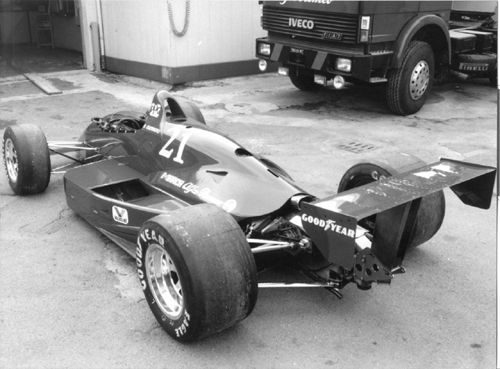
One of the Morales Racing-owned March 88Cs as used by Howdy Holmes during the 1988 season, as it appeared during the press conference. (photo Alfacorse PR)
Photographic evidence of the car as present at Balocco makes it possible to identify the car as a March 88C. The car still featured some of the decorations it wore as an Alex Morales Racing car in the 1988 CART season the year before. The Cosworth-powered cars had been used for obtaining reference data to compare the new and still to be built hardware with, once the new cars had become available. Further tests with the older car were planned with drivers Roberto Guerrero, Bruno Giacomelli and Pianta himself on the high-speed Narḍ oval. Narḍ was said to be selected because of its similarities with Indianapolis.
However, Narḍ's banking was steeper than the 9-degree incline at IMS, and Indy's corners were also tighter than the near permanent radius of Narḍ. (Narḍ is in fact a never-ending straight, with 20-degree banked turns in a 2km radius.) But Narḍ did at least offer the opportunity to do high-speed driving (with the pedal to the metal) for a prolonged time similar to what was possible at Indy.
The expectations for the newly designed 1989 car were that it would be ready in March for early US tests, with the intention to participate in the 'Month of May' at Indianapolis. (Talk about diving in at the deep end for your debut...)
A new engine design was on the drawing boards before it was to be built. But to compare this new engine, engineer Claudio Lombardi was testing Cosworth DFX engines on the dyno, as well as the stillborn Ferrari 034 engine.
The same magazine carried an extensive interview with Roberto Guerrero. Roberto revealed that he rated the Alfa deal as one of his biggest opportunities ever but that he had reasons to regret leaving Vince Granatelli Racing. Granatelli had not been able to secure a Chevy Indy V8 deal and instead of continuing with the Cosworth DFX he was taking a gamble. For 1989, Granatelli intended to use the stock-block Buick V6 engines in his cars. Just like USAC at Indy, CART allowed such engines but unlike at Indy, though, the Buicks were still permitted a healthy 0.9 litres of extra capacity. However, they did not enjoy Indy's boost advantage, so had to run at the same boost levels as the purebred V8 engines. This gave the Buicks a power output that was at best comparable with those V8s but with the handicap of a smaller rev range and less optimal throttle response. And, of course, the Buicks were known to be less reliable. Roberto said it was a promising programme and believed that the Buicks would be difficult to beat once the difficulties with the engine were sorted properly. But he preferred the more professional and better paid Alfa deal instead. Now, Roberto definitely needed a hefty pay check since he had to buy his way out of the contract with Granatelli Racing. In fact, he mentioned a figure of $160.000 required to be handed over to Granatelli.
Roberto acknowledged that he would have a late start to his season and that he would have to miss the first two races of the season. Team manager Capels had decided against racing a Cosworth-powered car in those early races and opted to start the season at Indy with the new Alfa-powered car. Interestingly, the type designation for the car used in this article was 89C.
One may wonder if this decision was in fact much more a result of the situation the team got into instead of a decision between different options made. At least one of the Morales owned 88Cs was used as a test car for the Alfa V8. And since it was not out of the question that the second car was also to be used for the test program in Italy, the question becomes what cars the team could have used to race with! Given the contract with March, then the team must have looked for possible 88Cs that were put on the used Indycar market. As we will see later on, some 88Cs were indeed made available to interested customers. But then it would be a lot of efforts and investment for what eventually were to be just two races before the Alfa-powered car would make its debut. So what was said to be a decision was very likely the most sensible thing to do: accept the consequences of decisions already made.
Not mentioned in Autosprint but here is some insight into the team that collaborated with Alfacorse, Morales Racing.
Morales Racing was founded by owner Alex Morales, and goes back far in the history of US open wheel racing, having fielded sprint cars with some success as early as the twenties. In 1975, the team stepped up into the world of Indycar racing, with limited success. When the USAC vs CART war started in 1979, Morales Racing went along with CART, and in 1981 they scored a major victory by winning the Michigan 500 with Pancho Carter driving their second-hand Penske-Cosworth. Next year, the team scored a neat third place (with a March-Cosworth 82C) behind the legendary duel between Gordon Johncock and Rick Mears.
In the years that followed, the team remained a midfield contender but had some highlights to celebrate with for example a fourth place at Indy in 1984, with Al Holbert driving. In both 1985 and 1986 the team scored a race win during the CART season with Johnny Rutherford driving. The 1986 victory was yet another Michigan 500 victory.
Results thereafter were less impressive, and failed to include any highlights. This could be credited to the fact that the team remained active with the latest March chassis, and the 1987 and 1988 types 87C and 88C were definitely not among the most competitive models in their years of date.
As for the drivers, it might be argued that Johnny Rutherford was in his forties (he had debuted at Indy in 1963 but became a three-time winner in 1974, '76 and '80) and had more of a reputation on ovals and (in the past) on dirt. He was perhaps by now reaching the end of his stellar career, although we cannot predict how well he might still have performed at a top-line CART team.
Howdy Holmes, who drove for the Morales team in 1988, was no truly acknowledged hotshoe and more of a pay driver with a healthy sponsor behind him. Nevertheless, he had some career highlights that proved that in a top team in a good car he was capable of delivering the goods. Qualifying second next to teammate Tom Sneva in the 1984 Indy 500 was such an example.
Anyway, Morales definitely still had a team with promise, and with decent drivers, but sadly for the team, Alex Morales died late November 1988. Chief mechanic, and effectively team principal, Johnny Capels took over the team and guided it into a promising future: being part of a factory effort.
Nevertheless, Alfacorse's choice of teaming up with Alex Morales Racing may cause some wonder. Why not team up with a high-profile team instead of the much more humble Alex Morales Racing?
The answer is fairly simple. Because of the contract signed between Alfa Romeo and March it meant that it was pretty much a matter of finding a team that still wanted to remain loyal to March, and we already saw that March had lost just about every customer it still had in 1988.
Morales Racing remained in a position to continue with March chassis while being the beneficiary of becoming a factory-supported team. For 1989, March continued its cooperation with Porsche by building them an exclusive car (named 89P) but not a single top CART team was interested in a new March 89C. The only team other than Porsche that was interested in running a March chassis was Morales Racing and no doubt that this was influenced by the fact that this deal came with a factory engine deal. But there was a benefit for Alfacorse too.
Teaming up with what was very much a midfield contender at best also enabled Alfacorse to operate under less stress than would have been the case if they had joined forces with one of the top teams and a highly rated driver. Expectations for outstanding performances were reduced, offering the opportunity to work on making progress during that first year out of the spotlights reserved for the top teams.
Besides that, some of the top teams that would be on Alfa's list were teams permitted to buy the Chevy Indy V8 engine. During 1988 the Chevy not only came good but also became near perfect and the one item almost vital to be competitive. Maybe some of the 'chosen few' could be persuaded to drop the Chevy in return for becoming part of a factory-supported programme with all the benefits that would bring. But that would also mean the risk of ending up in yet another heartbreaking programme of trying to make the engine competitive, similar to what had happened with the Chevy between 1985 and 1987. It is surprising to notice how many fans remember the Chevy Indy V8 being the all-dominant engine of between 1988 and 1991 and have all but forgotten the frustrating early years in which the engine was promising but not delivering at all. Only in 1987 at long last the Chevy became a race winner and in 1988 the teams on the Chevy programme had finally got an advantage on everyone else apart from their fellow Chevy users. Giving up on that was certainly a gamble if it came down to results in the short-term future.
And finally, there was one other factor involved for those top teams, one we have mentioned briefly already.
If anyone wanted the Alfa engine to become a team with a factory deal, it came with the obligation to work with March as well. As we have seen, late 1988 just about every top team in CART had lost its faith in March as a capable chassis constructor. And would that faith return because of the Alfa engine deal forcing them to run March chassis again?
Certainly at the time when the opportunity was there to express interest in becoming a March-Alfa partner, Alfa was a near certain no-performer and there were no signs yet that March was out of the doldrums. Remember, the only truly competitive 88C-mounted team had been Galles, and only on tracks of a certain kind and not all round. The man largely responsible for the 88C had left the organisation and made his 'child' successful after all after joining one of the teams that had used 88Cs, and he would remain with this team. A major loss that March had already felt during 1988 and would have lasting consequences.
Apart from the doubts about the hardware March had supplied to its customers in the last two years, March's customer service department March had not always acted in the way that customers had expected after their money had gone into the March bank accounts. (Mike Lawrence, March)
In our 1990 March-Alfa story, Johnny Capels assisted with the parts devoted to the 1989 build-up towards 1990. He wrote the following about the way he and his team joined the Alfacorse project:
“The March Engineering Alfa project was a project of Johnny Capels Enterprises DBA Alex Morales Autosports of which I was vice-president. My long time friend Alex had passed away in late 1988 and I went and brokered this arrangement between myself and March Engineering's Dave Reeves. I kept Alex Morales Autosports entity as the employer of our team and paid for those services as this was put together in Italy and England around Christmas of '88. I bought the few assets of Morales Autosports from the new leader of Alex Foods at the end of the '89 season as the shop and property and equipment was always mine in Indy. The negotiations went very well and I enjoyed working with the Alfa people very much. I was the team March was furnishing Alfa for this start up program. The Alfa leader was Cesare Fiorio, the project manager was Giorgio Pianta, and the operations manager was Claudio Chierici.”
Capels also told how he sold off two Cosworth DFX engines to Alfacorse. These were sent to the Abarth facilities in Turin to provide a baseline from which to evaluate the progress of their own engine. Alfa got a rude awakening. Their V8 had some 100 hp less! It resulted in a number of changes made to the specifications and people assigned to the project.
Continuing again with the backbone of this write-up, Italian magazine Autosprint. It printed further details about the progress of the programme in their February 21st edition which contained an article about the newly finished engine. It was revealed that FIAT Group had confirmed the Alfa project on October 1st, 1988 with a deadline of February 13th for the first engine to be sent to England and fitted in a chassis. The deadline was met with one day to go. The engine was said to be installed in a March 88C.
The car would be brought back to Italy for tests at Monza later in the month and at Narḍ as well. Meanwhile, at Abarth in Turin, a second engine was on the dyno and involved in reliability tests before trying to obtain more power. When the engine design was finalised the definitive engine would be built into the new 89C, which would then be shipped off to the US for tests at Phoenix and maybe Michigan.
The article also gave a number of technical details about the engine.
With respect to details about the actual March 88C chassis that were used for this project, we need to look to Autosport for hard information. Autosprint had not paid attention to this but the February 9 edition of the British magazine said that Bruno Giacomelli had been invited to join the Alfa test programme. Bruno had actually driven at Balocco using the two Morales Racing-owned March 88Cs still fitted with Cosworth DFX engines. Giorgio Francia and Roberto Guerrero had also driven with a car. But at the time of printing (February 9) the cars were presumably in England to be reworked for installation with the Alfa V8 engines.
The meeting described in the February 21 edition of Autosprint was also attended by famed British automotive journalist and historian Doug Nye. Autosport printed his article about the Alfa project and meeting in the edition dated February 23rd. Nye mentioned that he had seen and identified March chassis 88C-009. This is indeed one of the two cars used by Morales Racing the year before. Positive identification of this car racing in the 1988 Indy 500 is known through the 1988 Carl Hungness Indy 500 yearbook. Initially it had been intended as the backup car at Indy (USAC# 34, running and listed in the entry list as 21T) but on the final day of qualifying (Sunday, May 22nd) Howdy Holmes made it into the field with the car as the slowest qualifier. In the race he eventually finished a respectable 12th.

Howdy Holmes on Bump Day, May 20th, 1988, going out for another test in what was intended as his back-up car, March 88C-009. Later on the day he qualified this car for the race. On the right Raul Boesel's Lola T88/00, a car that his team had acquired from AJ Foyt a few days earlier to replace their recalcitrant 88Cs. (photo HG)
Nye also supplied an article about this Alfa press conference to Fast Lane which was printed in the May edition of this magazine. Here, Nye mentioned that 88C-009 was the programme's test-hack but also that he made another observation on that day. In a corner and not being talked about stood a white-painted monocoque that carried an Alfa decal on the nosecone. He eventually identified this mysterious chassis as nothing less than the stillborn Ferrari 637 Indycar.
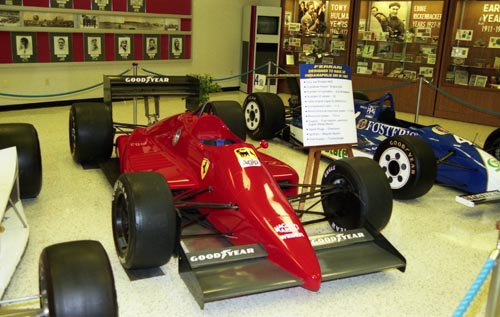
After whatever it did contribute to the start of Alfa's CART programme, the Ferrari 637 was restored and went into the collection of the Ferrari museum, although for a limited amount of time the car made it to the Indianapolis Motor Speedway after all when it went on exhibition in the Speedway Museum in early 1994, when this picture was taken. (photo HG)
Another interesting comment that Nye included was the fact that Alfa Romeo and March had been in talks based on CART considering 3.5-litre atmo engines but when the turbocharged engines were retained for the foreseeable future, the decision was made to build such an engine as well.
In their 13th issue of 1989, dated March 28th, Autosprint reports about the tests held at Monza earlier that month.
For these first tests a modified 88C powered by the Alfa V8 was used. The car appeared in road-race trim, with large front and rear wings. The engine was reported to produce 680hp, still some 50hp short on the Chevrolet engine and also on the Porsche V8.
(This suggests that the Chevrolet and the Porsche engines had near equal power output levels. There is, however, some doubt whether already at that time the Porsche V8 was truly at the same power level as the Chevrolet, if it has ever been to begin with.)
The new purpose-designed 1989 car, still named 89C, was supposed to be ready on April 19th.
A picture appears in the article that shows a second car behind the Alfa-powered 88C. It is difficult to identify but has the tiny front wings of an Indycar in speedway trim. There is no easy giveaway to identify it other than that the rollhoop seems to suggest it is another 88C. This would all but confirm that indeed both Morales-owned 88Cs participated in the Alfa Indycar test programme, with both cars having been in Italy. This Monza test appears to be one of the very few occasions if not the only one when two 88Cs were spotted on an Italian track, with photographic proof existing in print and/or on the Internet.
A number of race fans have shown an interest in the identity of the cars. As for the two ex-Morales cars, the identity of at least one car had been revealed by Doug Nye in his Autosport 23/2/89 article when he mentioned having seen 88C-009. For the identity of the second (ex-Morales) car, read Appendix 2.
We did obtain some more information about this test from another source, the Alfacorse USA Press Dept.
The bulletin they released mentioned that the actual test took place on March 23rd, the car that was used was described as the Alfa Romeo/March 88 Laboratory car, a highly modified version of the '88 version, the modifications having been supervised by Maurice Philippe who was also responsible for the design of the new 1989 car. The press bulletin referred to the car as the 89CE. Both intended driver Roberto Guerrero and Alfa's test driver Bruno Giacomelli took the car out for a combined total of 106 laps, only being stopped from further laps due to sunset.
Johnny Capels, who attended the test, was quoted as having said: "I'm thrilled that we were able to conduct the car's first shakedown and worry about things like fuel mapping and other 'tunable' things, rather than having to be concerned with whether the engine would hold together or not. The Alfa people brought a soundly designed engine to us which, I'm confident, will ultimately prove out to be competitive. We obviously need to do a lot of testing and our target of debuting the car at Indy is a tall order, but everyone at Alfa Romeo March Engineering, and my guys will be doing everything within our collective power to make that happen."
At about the same time Autosport revealed a curious detail about the situation between Alfa Romeo and March in their edition dated March 30th. They referred to a press conference in Italy late in the week before which mentioned the test session held on March 23nd. Their report about this press conference stated that Ing. Claudio Lombardi revealed that unlike what many believed it was still not 100% certain that Alfa would race with March chassis once the test phase was concluded! His words were: "We are negotiating with March and will probably go with them, but will make the decision at the end of testing." Managing director of March, Dave Rees, did confirm the fact that there was no contract signed yet.
If this really was the case, think about what could have happened if Alfa Romeo had decided against going with March. All of the work put in by March on the 89CE would have been for nothing, and what about all other consequences? But then, what alternatives did Alfa have? Buying a Lola and having that car modified? How much time would have been lost and wasted if another brand of chassis was to be selected? It could have been interesting for the lawyers of both March and Alfa Romeo to sort out how to separate one thing from another and who had to pay for what efforts.
But since the two companies were still cooperating, it appears there must have been a lot of faith between the two intended partners.
Early April (4th) Autosprint announced that the new Alfa-powered Indycar built in England at the former Ralt factory was getting ready. All this while in Italy at the tracks of Monza, Mugello and Narḍ the elderly yet Alfa-powered 88C had been tested extensively. The team was confident as both power and reliability were said to be pretty good and the team did expect to be present at Indianapolis next month May.
One week later (April 11th), Autosprint reported that after tests at Monza new tests were scheduled at Mugello from April 18th to 20th. This was still with the old 88C, while the new '89 car was to be tested at Phoenix.
But the very same Autosprint edition also featured a picture of an elderly Lancia LC2 fitted with an Alfa V10 engine being driven at Mugello in preparations for the 1990 Gp C season. If anything, it was the proof appearing in Autosprint of the fact that the Indycar project definitely didn't receive the full 100% attention of Alfacorse. There were other things going on over there as well.
And so, here at last followed the photographic evidence of what Alfa had announced at that late-March press conference. In their article about that meeting, apart from all the Indycar news, Autosport also printed statements by Giorgio Pianta in which he told about an old Lancia LC2 chassis being used for tests with a V10 engine. It was the intention to have a newly designed chassis being ready at the end of the year and possibly being raced at the end of the 1990 season in preparation for the 1991 season.
If attention to other projects than the Indycar had affected progress, who knows. Fact is that on April 18th Autosprint reported first trouble with regards to the chances of the team participating at Indianapolis. The production of the new car at England was delayed and because of that, planned tests at Phoenix were likely impossible. Instead it was planned to send the car to an (undisclosed) track near Indianapolis to be tested by Roberto Guerrero. These tests would be decisive on the question to go to Indianapolis of not.
Meanwhile, testing in Italy with the 88C had continued with Giorgio Francia driving the car on the Marene public motorway, the A6 between Turin and Savona! For this purpose, a piece of the motorway was closed off for traffic in order to carry out some new boost specs.
We can safely assume that this test was not carried out during rush hour! But we may wonder how people who on that particular day and time were forced to take a detour would have felt about the reason for their inconvenience, if they ever found out why.
Could Autosprint have been falsely informed or were plans changed on short notice all the time? Anyway, in their last edition published in April '89 (dated April 25th) they reported that the new 89C (the type registration still being used for the car in Autosprint) had arrived in Italy, at the Arese factory. So much for the plans of the car being sent off to the USA for tests over there!
The car was said to be prepared for a test on April 26th at Mugello while there was still talk about the engine being very reliable and having a lot of potential. For this test, a Cosworth-powered 88C was brought over as well to test the cars in similar aerodynamic configurations and compare the new car against what was a known quantity in Indycar.
The comments about this test raise a question since the team claimed that the Alfa-powered 88C was about a second faster than the Cosworth-powered version. But since the actual car was in Italy, why was the new 89C (sic) not compared against the 88C-Alfa muletta?
Anyway, the Alfa crew expressed their confidence as the Alfa engine was still in the initial phases of its development. One problem was mentioned, though: engine response coming off turns could be better. Test driver Bruno Giacomelli claimed that better lap speeds would be possible if the car used a more optimal 5th-gear ratio.
There is a bit more to tell about the final stages of work on the 89CE before it left the workshops where it was finished. Johnny Capels informed us about the following. It was his crew that completed the two 89C cars, and they discovered that it had a complete miscalculation on the make-up of the tub and the torsional rigidity it should have had. There was, however, no more opportunity to correct this and the cars eventually went to the USA as they were and raced as such.
For a moment we will leave the 'Autosprint backbone' and turn to the British Autosport magazine. In their edition dated April 27th, 1989 (a Thursday) they included a picture of the 89CE parked in front of what was said to be the Weybridge factory the Wednesday before. It was sent off to Italy that day. Logistics involved when dealing with a magazine printing and release this means that the picture must be taken on Wednesday April 19th.
Freely available pictures of the 89CE are rare and difficult to locate, other than its press kit contents. On the Marchives site entirely devoted to March cars and history, a set of pictures can be found. Some of those look remarkably similar to the one shot printed in the Autosport April 27th edition. Contact with Marchives learned us that it is not known (anymore) who uploaded these pictures.
Normally we would not have abused the right to publish these pictures here. But after consulting with the Marchives website owner, we decided to tell what we know about these pictures and where the full set can be found. So in order to be able to show at least some pictures that were made in that time frame of the actual cars, we hereby reproduce a few of those pictures as they appear at Marchives.
We call upon the photographer to contact us if he wants to have his/her name added as a credit line or prefers the pictures to be removed, which we will do if so requested.
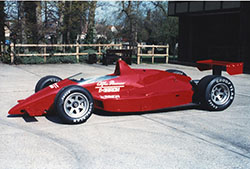
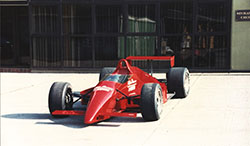
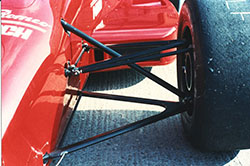
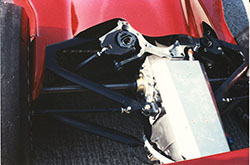
Photos of a March 89CE that was just finished, as they appear on the Marchives website. These pictures were likely taken on April 19th, 1989. (copyright unknown)
In the first May edition of Autosprint (dated May 2nd), the magazine reports that the new 89CE finally made it onto the track. Interestingly, this is indeed the first time that the identification 89CE appears in the Italian magazine.
By the way, what's in a name? Autosport magazine had referred to the new Alfa-powered Indycar as the 89CE but in the edition that introduced the car they referred to it as 89CR! Given the locations of the E and R on a typewriter or computer keyboard, perhaps an editorial 'typo'?
Unlike earlier announcements, the car did not make its first runs in the USA as initially suggested, but their announcement of the week before that the car would run at Mugello turned out to have been correct. Photographic evidence printed with the article confirms this. A car is seen with pullrod front suspension, the 'at first sight' giveaway to separating the 89CE from the 88C. Other than that, the new car resembled the familiar lines and shapes of the 88C. It took a bit more time to look for details to be able to identify the new 89CE from its older brother and source of inspiration.
It was also reported that Bruno Giacomelli again drove the faithful 88C 'muletta'. Some minor electronics problems on the engines were diagnosed as well as a slight lag on the turbo boost but other than that the reliability was described as being no problem.
Since the 89CE arrived with Superspeedway wings, the tests on the Mugello road course were carried out with type-88C wings installed on the car.
One major disappointment had to be mentioned and swallowed as well by now. The debut at Indianapolis that was hoped for was no longer an option. Claudio Lombardi, one of the hotshots in the entire project, stated that: “We could go to Indy but the succession of races and the delivery delay of the car advise us against it.”
The 1989-90 CART Annual mentions that the cancellation to go to Indy was due to a labour strike in Italy. (A reason that has affected more races by Italian teams in the past.)
However, Johnny Capels had a different explanation. He informed us: “With our help in the March shop we did have two new '89 March models ready for Indy but the progress of the engines was not to Alfa's satisfaction. The March chassis was conceived very quickly and basically was not anything new.”
Capels also confirmed that there had indeed been problems with the engines being finished in time but he hadn't been aware of strikes taking place in Italy. Work was carried out all the time and there was a lot of faxing and telephoning going on. The team had built up the chassis and these were ready in time.
But whatever was cited as the reason for withdrawal, the team was forced to withdraw from Indianapolis because the engines weren't ready, neither in quantity nor at the level of performance needed. Johnny Capels admitted so much that with the performance levels of the Alfa engines at that time (during the Month of May) it would have been doubtful if the car was fast enough to be qualified if the team had been present at the Speedway.
Autosprint reported two weeks later that by the time Pole Weekend was on at Indy (May 15th & 16th) an 89CE did arrive in the US. But although garage space was made available in Gasoline Alley, the 89CE failed to show up.
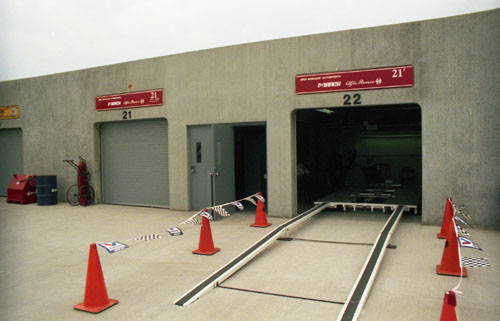
The signs were there, above the garages in Gasoline Alley in May 1989, but the team never showed up. (photo HG)
Instead the 89CE was directed to Grand Rapids, MI, in order to be tested on the General Motors test track.
If you think about it, it was quite a funny situation that a FIAT-Chrysler joint venture was tested at facilities owned by GM, all the more since the project was supposed to go up against a GM-supported opponent, the Chevrolet-branded engines made by Ilmor.
Not mentioned in Autosprint but for the sake of detail, the 1989 Carl Hungness Indy 500 Yearbook stated that Roberto Guerrero was not released by his Alfa paymasters to accept another drive for Indianapolis only. As a result of that, he had to turn down an invitation to drive a Truesports entry. In a different article in the same publication, Roberto suggested that the reason for him not being released was the fear of becoming injured (or worse) before the Alfa programme could take off. Given the dangers of Indy that was not such a strange thought at all. Indy had seen at least two cases of drivers killed while driving cars they were not assigned to but were testing as a gesture: Keith Andrews who was killed while testhopping Giuseppe Farina's car in 1957 and, most famously, Tony Bettenhausen while testhopping Paul Russo's mount in 1961. Bettenhausen made that fateful testhop having been the fastest driver in practice up until that moment...
And then, to top it off, Roberto himself had been seriously injured late 1987, due to a heavy crash in testing. So to some extent, he had proven already to his paymasters to never allow a driver to take any more risks than strictly necessary.
While the rest of the Indycar teams were busy at Indy, in their second week of practice and qualifying, Alfacorse was by now active in the US as well, testing the new '89 car at the Grattan Raceway near Grand Rapids, MI. Team manager Johnny Capels had selected the venue as it offered some resemblings with the Detroit track, the venue where the car was aimed to make its debut. Further tests were planned to take place at Mid-Ohio. The Alfa people were still confident that apart from some electrical problems there were no reliability issues, while straightline speeds had been enhanced thanks to a newly designed rear wing. For what it was worth, the fastest lap for the Alfa-powered car driven by Guerrerro was 1.3 seconds faster than registered by a Doug Shierson-owned Lola-Judd driven by Raul Boesel.
To put this performance into perspective: it needs to be remembered that the Judd V8 wasn't the most powerful of the Indycar engines around at the time. We can only guess what a Chevy-powered Penske or Lola would have done at the track, but for the time being there was still some optimism in the Capels-run camp.
The pictures with the article show a car that still resembled the more familiar March 88C but with the giveaway trademark of pushrod front suspension clearly visible.
And while Guerrero was testing his Alfa-powered '88C Mk2', the genuine 88Cs entered at Indy were not setting the world on fire. No top team had entered 88Cs, and the few 88Cs that did show up were primarily with teams that raced at Indy only. All of them had Cosworth DFX engines but only two of them made it into the starting field. In fact, there were three teams trying their luck with second-hand 88Cs but only one driver (Kevin Cogan) qualified his original mount. Teammate Rich Vogler couldn't make his own 88Cs work but eventually qualified Cogan's backup car.
Meanwhile, an elderly 86C made the field, while several Lolas built in '87 and '88 were in handsomely, as were a few Penskes of the 1988-type PC17. For the sake of completeness: no 87C was fast enough to qualify that year, to some extent making the presence of that lone 86C in the starting field even more remarkable.
Despite the relatively poor showings of the few 88Cs present at Indy, the optimism at Alfa had remained. But all of that changed one week later.
In the May 30th edition of Autosprint the Indianapolis 500 received a lot of coverage but there was news about the Alfa tests at Mid-Ohio as well. Also attending the test were the IMSA Jaguar team with one of their new turbocharged V6 cars and, of more interest because of the comparising options, Scott Pruett with a Truesports Lola-Judd T89/00. The two-day test was cut short to a few hours due to rain.
The test revealed a number of issues on the car that were not to be solved easily. It was said to have no grip and bad traction coming out of the corners. The engine was misfiring at lower revs and about the only thing that was satisfying was its reliability.
Somehow, this claim about reliability is a bit strange in light of the misfires that were mentioned. Or did Alfa judge their self-produced hardware while excluding all auxiliary components supplied by others? Or was reliability 'OK' as long as there was no complete engine failure?
As for performance: Roberto Guerrero had been a whopping 3.5 seconds slower than Boesel.
And again, keep in mind that a Lola-Judd could not be rated as the fastest chassis & engine combo around. How much faster could a Chevy-powered Lola or Penske be?
Curiously, the test took place without the presence of designer Maurice Philippe, and neither Alfa nor March had sent important people from their organisations to attend and guide the test. Certainly in the light of what was yet to come, the absence of Philippe was perhaps a telltale sign. Bicester had sent, of all people, a cousin of Gordon Coppuck, one of the men behind the design of the other type-1989 March Indycar, the Porsche-powered 89P! But cousin Coppuck's skills to provide valid solutions as well as the authority to take decisions were questioned.
The 1989 CART Annual says that Gordon Coppuck's cousin's first name was Frank.
After this test the team was off to Michigan to do tests on the Michigan International Superspeedway.
The June 6th edition of Autosprint reported about tests by Bruno Giacomelli with the 88C-Alfa at no lesser place than the Ferrari test track of Fiorano. But he had trouble getting up to speed and his lap time of 1:12:4 was only slightly faster than that of an F40!
Meanwhile, Guerrero and the 89CE were testing at the Michigan oval. Although the car once again showed creditable reliability with over 700km run without engine failure, the speeds were not that encouraging, Roberto reaching an average of 209.4mph (337kph) while the year before the Michigan 500 pole sitter Rick Mears qualified with an average of 357kph. For the record, 700km is not a full race distance at Michigan yet. That is some 804km.
This figure listed for Mears is a bit too optimistic. The 1988 CART Annual mentions Rick's pole speed as having been 218.417mph which corresponds with an average of 351.4kph. So Autosprint made things look even worse for their fellow countrymen.
Guerrero was positive about the engine yet complained about the car's handling.
These tests were carried out by a team unknowing what cruel fate was to befall them within days, the impact of which is difficult to determine.
And of all things, this cruel fate was related to one on the people attending that test, since based on personal correspondence between Johnny Capels and Henri, after missing the tests in Mid-Ohio, Capels mentioned that for the tests at Michigan, designer Maurice Philippe had been attending these tests at the Michigan oval and then returned to England.
The following week (June 13th) Autosprint reported about the tragic setback that befell Alfacorse little over a week earlier, as the designer of the new March 89CE, Maurice Philippe, had taken his own life. We can only guess what has went through Philippe's mind before making such a dramatic decision. But curiously, before his final act in life Philippe had prepared instructions to how to develop the car and some work for the 1990 car and sent these off. According to Autosprint, the new designer leading the March part of the March-Alfa project was a man then referred to as Dave Rives.
However, the name of Dave Rives is unknown in the history of March. It was a hiccup that Autosprint was to carry on for the remainder of the articles devoted to the March Indycar programme during 1989. The man's real name was Dave Reeves and according the CART Indycar Annual for the 1989 season he was the Managing Director of March who had assigned Maurice Philippe onto the Alfa project. The same source also listed that after Philippe's death responsibilities were taken over by Frank Coppuck, the cousin of better known designer Gordon Coppuck, a man who had made quite a name for himself in F1. (Gordon Coppuck was primarily known for designing McLaren's F1 cars in the seventies but also responsible for the hallmark McLaren-Offy M16 Indycar that debuted in 1971 and in updated versions remained the works cars until 1976.)
It shall never be possible to fully comprehend or estimate the impact Philippe's death was to have for the early phase if not for the entire Alfa Indy project. With hindsight knowledge of how 1989 would turn out for the team and the kind of hardware that was to follow the 89CE in 1990, would all this have happened if a Philippe in good health would sill have been part of the project? All the more given the fact that he had left instructions on how to continue the development process of his last 'child'.
In the wake of this setback, Alfa announced that 1989 was to be a learning year while the team expected to mix it with the top teams in the 1990 season.
Looking at the most recent progress with the 89CE, the car had finally made it to Indianapolis! Although it instantly has to be said that it was not on the famed 2.5-mile oval. After the most recent tests held at Indianapolis Raceway Park, the car was declared to be good enough. Some of the recent difficulties had been addressed, using adjustments applied after communications with Italy. The team had also tried new wings. The lap times achieved at IRP were reported to be a little slower than times recently set by other (undisclosed) teams.
All this was happening while Giacomelli was still testing the 88C 'muletta' at the Fiorano track.
But the time of testing only was over by now. It was mid-June and Alfa Romeo and their partners were ready to make their CART debut.
